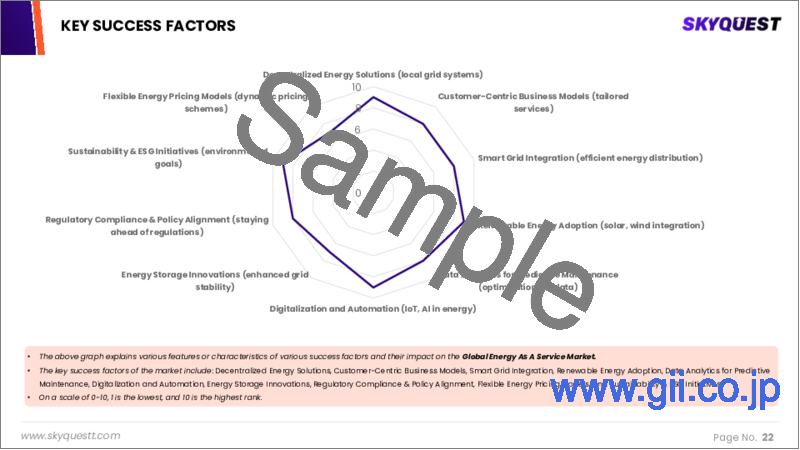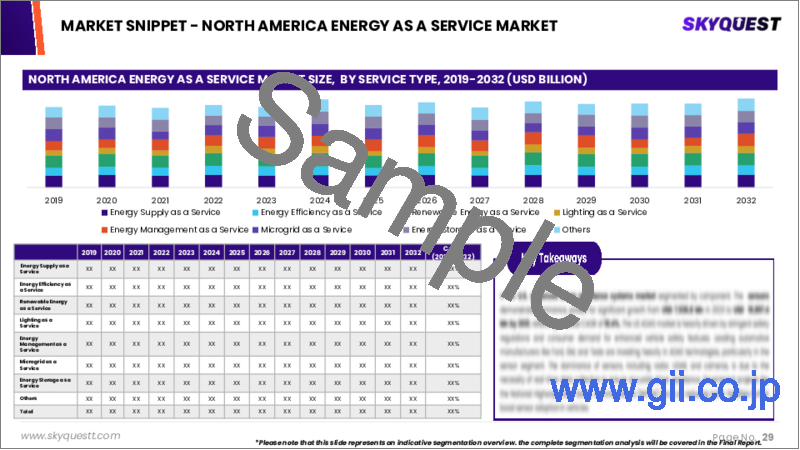|
|
市場調査レポート
商品コード
1619246
サービスとしてのエネルギー市場規模、シェア、成長分析、タイプ別、エンドユーザー別、地域別 - 産業別予測、2024~2031年Energy as a Service Market Size, Share, Growth Analysis, By Type (Energy Supply Services, Operational & Maintenance Services), By End User (Commercial, Industrial), By Region - Industry Forecast 2024-2031 |
||||||
|
|||||||
| サービスとしてのエネルギー市場規模、シェア、成長分析、タイプ別、エンドユーザー別、地域別 - 産業別予測、2024~2031年 |
|
出版日: 2024年12月17日
発行: SkyQuest
ページ情報: 英文 182 Pages
納期: 3~5営業日
|
全表示
- 概要
- 目次
サービスとしてのエネルギーの世界市場規模は、2022年に623億米ドルと評価され、2023年の689億米ドルから2031年には1,543億米ドルに成長し、予測期間中(2024年~2031年)のCAGRは10.6%で成長する見通しです。
エネルギー分野は大きな変革期を迎えており、サービスとしてのエネルギー(EaaS)市場は複数の促進要因によって拡大しています。主な影響要因としては、分散型エネルギー資源(DER)の台頭、エネルギー効率化に対する税制優遇措置、公益事業者が新たに得られる収益、再生可能エネルギー生産・貯蔵におけるコスト低下などが挙げられます。エネルギー消費の増加、価格変動、再生可能エネルギーの可能性は、この市場の成長をさらに促進します。組織は現在、持続可能なエネルギー・ソリューションを優先しており、より幅広い顧客層を惹きつけるために、エネルギープロバイダー間の協力につながっています。米国やカナダのような先進国の支援政策が、EaaSの採用を促進しています。政府の投資が増加する中、EaaSは顧客に合わせたエネルギーソリューションを提供し、エネルギー発電と蓄電の統合を最適化すると同時に、価格設定と所有権における顧客の選択を強化しています。
目次
イントロダクション
- 調査の目的
- 調査範囲
- 定義
調査手法
- 情報調達
- 二次データと一次データの方法
- 市場規模予測
- 市場の前提条件と制限
エグゼクティブサマリー
- 世界市場の見通し
- 供給と需要の動向分析
- セグメント別機会分析
市場力学と見通し
- 市場概要
- 市場規模
- 市場力学
- 促進要因と機会
- 抑制要因と課題
- ポーター分析と影響
- 競争企業間の敵対関係
- 代替品の脅威
- 買い手の交渉力
- 新規参入業者の脅威
- 供給企業の交渉力
主な市場の考察
- 重要成功要因
- 競合の程度
- 主な投資機会
- 市場エコシステム
- 市場の魅力指数(2023年)
- PESTEL分析
- マクロ経済指標
- バリューチェーン分析
- 価格分析
- 技術の進歩
- 規制情勢
- ケーススタディ
- 特許分析
- 貿易分析
サービスとしてのエネルギー市場規模:タイプ別
- 市場概要
- エネルギー供給サービス
- 運用・保守サービス
- エネルギー効率
- 最適化サービス
サービスとしてのエネルギー市場規模:エンドユーザー別
- 市場概要
- 商業用
- 産業用
- 住宅用
サービスとしてのエネルギー市場規模:地域別
- 北米
- 米国
- カナダ
- 欧州
- 英国
- ドイツ
- スペイン
- フランス
- イタリア
- その他欧州地域
- アジア太平洋地域
- 中国
- インド
- 日本
- 韓国
- その他アジア太平洋地域
- ラテンアメリカ
- ブラジル
- その他ラテンアメリカ地域
- 中東・アフリカ
- GCC諸国
- 南アフリカ
- その他中東・アフリカ
競合情報
- 上位5社の比較
- 主要企業の市場ポジショニング(2023年)
- 主な市場企業が採用した戦略
- 市場の最近の動向
- 企業の市場シェア分析(2023年)
- 主要企業の企業プロファイル
- 会社概要
- 製品ポートフォリオ分析
- セグメント別シェア分析
- 収益の前年比比較(2021-2023)
主要企業プロファイル
- ENGIE(France)
- Enel X(Italy)
- Schneider Electric(France)
- Ameresco(US)
- Siemens(Germany)
- General Electric(US)
- Veolia(France)
- Honeywell(US)
- Centrica(UK)
- Alpiq(Switzerland)
- Johnson Controls(US)
- Bernhard(Germany)
- Enel SpA(Italy)
- Spark Community Investment Co.(US)
- Electricite de France(EDF)SA(France)
- TotalEnergies(France)
- Orsted(Denmark)
- NextEra Energy(US)
- Iberdrola(Spain)
- Equinor(Norway)
結論と推奨事項
Global Energy as a Service Market size was valued at USD 62.3 billion in 2022 and is poised to grow from USD 68.9 billion in 2023 to USD 154.3 billion by 2031, growing at a CAGR of 10.6% during the forecast period (2024-2031).
The energy sector is experiencing a significant transformation, with the Energy as a Service (EaaS) market expanding due to multiple driving factors. Key influences include the rise of Distributed Energy Resources (DER), tax benefits for energy efficiency, newly available revenue for utilities, and lower costs in renewable energy production and storage. Increased energy consumption, price fluctuations, and the potential of renewables further fuel this market growth. Organizations are now prioritizing sustainable energy solutions, leading to collaborations among energy providers to attract a broader customer base. Supportive policies in developed nations like the U.S. and Canada are facilitating EaaS adoption. With rising government investments, EaaS offers tailored energy solutions, enhancing customer choice in pricing and ownership while optimizing energy generation and storage integration.
Top-down and bottom-up approaches were used to estimate and validate the size of the Global Energy As A Service market and to estimate the size of various other dependent submarkets. The research methodology used to estimate the market size includes the following details: The key players in the market were identified through secondary research, and their market shares in the respective regions were determined through primary and secondary research. This entire procedure includes the study of the annual and financial reports of the top market players and extensive interviews for key insights from industry leaders such as CEOs, VPs, directors, and marketing executives. All percentage shares split, and breakdowns were determined using secondary sources and verified through Primary sources. All possible parameters that affect the markets covered in this research study have been accounted for, viewed in extensive detail, verified through primary research, and analyzed to get the final quantitative and qualitative data.
Global Energy As A Service Market Segmental Analysis
Global Energy as a Service Market is segmented by Type, End User and Region. Based on Type, the market is segmented into Energy Supply Services, Operational and Maintenance Services, Energy Efficiency and Optimization Services. Based on End User, the market is segmented into Commercial, Industrial, Residential. Based on Region, the market is segmented into North America, Europe, Asia Pacific, Latin America and Middle East & Africa.
Driver of the Global Energy As A Service Market
One of the primary drivers for the Global Energy As A Service (EaaS) market is the rising adoption of renewable energy sources, driven by their cost-effectiveness, decreased carbon footprints, and enhanced energy efficiency. As both organizations and governments strive to lower their carbon emissions and shift towards cleaner energy alternatives, the demand for EaaS solutions is anticipated to grow significantly. The inherent flexibility and customization capabilities provided by EaaS, alongside supportive government policies and initiatives, further bolster the market's expansion. This trend signifies a crucial step towards sustainable energy consumption and greater environmental stewardship.
Restraints in the Global Energy As A Service Market
The Global Energy As A Service (EaaS) market is encountering significant obstacles that could impede its growth. A key restraint is the limited awareness and understanding among end-users about the advantages offered by EaaS solutions. Furthermore, the substantial initial investment required to adopt these solutions poses a challenge, particularly for small and medium-sized enterprises, potentially preventing them from entering the market. Compounding these issues are the absence of standardized regulatory frameworks and technological challenges, such as integration difficulties, which further contribute to the constraints that the EaaS market must navigate in order to realize its full potential.
Market Trends of the Global Energy As A Service Market
The global Energy as a Service (EaaS) market is witnessing significant trends shaped by technological advancements and shifting consumer preferences. The rise of digital technologies-including IoT, AI, and blockchain-enhances energy efficiency and cost-effectiveness. Concurrently, there is a marked shift towards decentralized, renewable energy sources like solar and wind, driven by the need to satisfy growing energy demands while minimizing carbon footprints. Additionally, customized and flexible EaaS solutions are increasingly appealing to end-users seeking tailored options that address their specific energy needs. This convergence of trends is revolutionizing how energy is consumed and managed globally, fostering sustainable practices in the sector.
Table of Contents
Introduction
- Objectives of the Study
- Scope of the Report
- Definitions
Research Methodology
- Information Procurement
- Secondary & Primary Data Methods
- Market Size Estimation
- Market Assumptions & Limitations
Executive Summary
- Global Market Outlook
- Supply & Demand Trend Analysis
- Segmental Opportunity Analysis
Market Dynamics & Outlook
- Market Overview
- Market Size
- Market Dynamics
- Driver & Opportunities
- Restraints & Challenges
- Porters Analysis & Impact
- Competitive rivalry
- Threat of substitute
- Bargaining power of buyers
- Threat of new entrants
- Bargaining power of suppliers
Key Market Insights
- Key Success Factors
- Degree of Competition
- Top Investment Pockets
- Market Ecosystem
- Market Attractiveness Index, 2023
- PESTEL Analysis
- Macro-Economic Indicators
- Value Chain Analysis
- Pricing Analysis
- Technological Advancement
- Regulatory Landscape
- Case Studies
- Patent Analysis
- Trade Analysis
Energy as a service market Size by Type & CAGR (2024-2031)
- Market Overview
- Energy Supply Services
- Operational and Maintenance Services
- Energy Efficiency
- Optimization Services
Energy as a service market Size by End User & CAGR (2024-2031)
- Market Overview
- Commercial
- Industrial
- Residential
Energy as a service market Size & CAGR (2024-2031)
- North America (Type, End User)
- US
- Canada
- Europe (Type, End User)
- UK
- Germany
- Spain
- France
- Italy
- Rest of Europe
- Asia-Pacific (Type, End User)
- China
- India
- Japan
- South Korea
- Rest of Asia Pacific
- Latin America (Type, End User)
- Brazil
- Rest of Latin America
- Middle East & Africa (Type, End User)
- GCC Countries
- South Africa
- Rest of Middle East & Africa
Competitive Intelligence
- Top 5 Player Comparison
- Market Positioning of Key Players, 2023
- Strategies Adopted by Key Market Players
- Recent Developments in the Market
- Company Market Share Analysis, 2023
- Company Profiles of All Key Players
- Company Details
- Product Portfolio Analysis
- Company's Segmental Share Analysis
- Revenue Y-O-Y Comparison (2021-2023)
Key Company Profiles
- ENGIE (France)
- Company Overview
- Business Segment Overview
- Financial Updates
- Key Developments
- Enel X (Italy)
- Company Overview
- Business Segment Overview
- Financial Updates
- Key Developments
- Schneider Electric (France)
- Company Overview
- Business Segment Overview
- Financial Updates
- Key Developments
- Ameresco (US)
- Company Overview
- Business Segment Overview
- Financial Updates
- Key Developments
- Siemens (Germany)
- Company Overview
- Business Segment Overview
- Financial Updates
- Key Developments
- General Electric (US)
- Company Overview
- Business Segment Overview
- Financial Updates
- Key Developments
- Veolia (France)
- Company Overview
- Business Segment Overview
- Financial Updates
- Key Developments
- Honeywell (US)
- Company Overview
- Business Segment Overview
- Financial Updates
- Key Developments
- Centrica (UK)
- Company Overview
- Business Segment Overview
- Financial Updates
- Key Developments
- Alpiq (Switzerland)
- Company Overview
- Business Segment Overview
- Financial Updates
- Key Developments
- Johnson Controls (US)
- Company Overview
- Business Segment Overview
- Financial Updates
- Key Developments
- Bernhard (Germany)
- Company Overview
- Business Segment Overview
- Financial Updates
- Key Developments
- Enel SpA (Italy)
- Company Overview
- Business Segment Overview
- Financial Updates
- Key Developments
- Spark Community Investment Co. (US)
- Company Overview
- Business Segment Overview
- Financial Updates
- Key Developments
- Electricite de France (EDF) SA (France)
- Company Overview
- Business Segment Overview
- Financial Updates
- Key Developments
- TotalEnergies (France)
- Company Overview
- Business Segment Overview
- Financial Updates
- Key Developments
- Orsted (Denmark)
- Company Overview
- Business Segment Overview
- Financial Updates
- Key Developments
- NextEra Energy (US)
- Company Overview
- Business Segment Overview
- Financial Updates
- Key Developments
- Iberdrola (Spain)
- Company Overview
- Business Segment Overview
- Financial Updates
- Key Developments
- Equinor (Norway)
- Company Overview
- Business Segment Overview
- Financial Updates
- Key Developments






